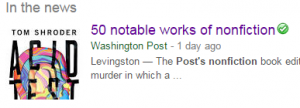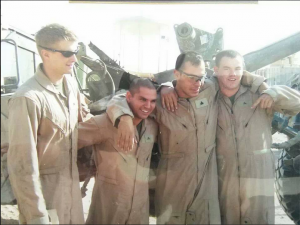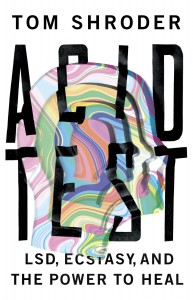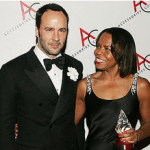 The Daily Beast just posted this ridiculously hyped story about dinosaurs “tripping on LSD.” http://www.thedailybeast.com/…/did-dinosaurs-drop-prehistor…
The Daily Beast just posted this ridiculously hyped story about dinosaurs “tripping on LSD.” http://www.thedailybeast.com/…/did-dinosaurs-drop-prehistor…
Not to be harsh, but what morons! The research shows ergot fungus in dinosaur remains. Ergot fungus is NOT LSD. It is a deadly rye toxin that killed hundreds of thousands in the Middle Ages. Lysergic Acid is one of many active components in the fungus, and must be extracted, then combined with diethylamide, an extract of ammonia, to make LSD. So the dinos were not “tripping,” though they may have been tripping and falling… down dead.
Author & Editor
Blog
Dino Doo Doo
Old Souls Made New Again
I learned a valuable thing about Google search I should have known long ago: You can limit your search for whatever search terms so that you only see recent posts. Using this method, I found a review of Old Souls (published way back in 1999) that I’d never seen before. It was probably the most thorough and thoughtful review I’ve ever seen of that book. Here’s the link.
Finding Chandra Is the New (Old) “Serial”
Huffington Post has directed addicts of the true-life crime mystery series “Serial” to some books that can take the edge of their jones, now that “Serial” is over, and that list includes Finding Chandra, by Scott Higham and Sari Horwitz, which was my first book editing project after leaving the Post.
Acid Test Makes 2014 Notable Nonfiction List
 The Washington Post placed Acid Test at the top of its notable nonfiction list for 2014. The only way it could have been even higher on the list was if the title had been Aacid Test. (It was alphabetical). But still … it was great seeing it up there with all those fabulous titles. Take a look here.
The Washington Post placed Acid Test at the top of its notable nonfiction list for 2014. The only way it could have been even higher on the list was if the title had been Aacid Test. (It was alphabetical). But still … it was great seeing it up there with all those fabulous titles. Take a look here.
Even A Blind Squirrel …
… Finds an acorn once in a while.
Jim Haag, an editor at the Virginian Pilot, just posted this on Facebook. I’d forgotten all about this, but it really ain’t bad advice!
A final dip into the archives: This great piece of advice, from the timeMichael Gruss and I got to work with Post editor Tom Shroder on writing and editing: “In the writing system of justice, every sentence is guilty until proven innocent. When you’ve got something down, go back and look at it sentence by sentence with serious skepticism, insisting that each sentence has to prove its worth (what does it accomplish?), logical consistency (is there anything that confuses, or doesn’t fully make sense?) and reader friendliness (does it engage, create an effect, lead a reader forward?)”
Bronco’s Sacrifice — an excerpt from Acid Test
Yesterday, Nicholas Blackston posted a photo of some of his Marine comrades from Iraq, members of a platoon that had joined Nick’s for a joint night mission. Midway through the mission, the Humvee they were in took a direct hit from an IED. Nick and his crew watched helplessly as the Humvee burned, one of the harrowing experiences that haunted Nick after he returned home from war. I’d never seen the photo before, though the names had stayed with me, indelibly pressed in my mind and heart ever since Nick shared his account with me. This photo, happy, healthy young men who’d heeded the call to serve their country in a moment of camaraderie just weeks or days from disaster, now haunts me. This is the story of their sacrifice, as it appears in Acid Test: LSD, Ecstasy, and the Power to Heal.

From left to right: Nathan Elrod, the machine gunner; Nicholas Manoukian (Manny), the radio guy ; Luis Blanco, the VC; Clifford Collinsworth, the driver. Photo courtesy of Nick Blackston.
Less than two weeks after the Charlie Company ambush, on October 21, Nick’s Light Horse platoon combined with Bronco platoon for a patrol in the city. They were a mirror image of vehicles and armament traveling in parallel along facing alleys. Bronco was led by Lt. Daniel Moran, the lieutenant Nick had accidentally tripped up back in training, and Lt. Boehlert’s close friend.
Now the two lieutenants shared a joint mission, escorting the Explosive Ordnance Disposal unit. The very nature of the EOD was to look for trouble, to roll into the most heavily booby-trapped territory with their thickly armored vehicles, their robots and their bomb suits searching out IEDs to mess with. At night.
Night missions were spooky, but at least Nick could stand up in his turret without feeling like a neon bullseye. The enemy didn’t have night vision gear, or at least that’s what they’d been told. Nick savored the unaccustomed luxury of a breeze puffing through his body armor as they rolled into the maze of alleyways. Nick’s Humvee, with Lt. Boehlert aboard, was in the lead going down one alley, and Moran’s Humvee led down the other when the sky ripped apart.
“I remember seeing this huge fireball go in the air,” Nick says. “And my lieutenant said, ‘What was that?” and I said, ‘There’s a huge fireball in the sky,’ and then the only thing I remember coming out of his mouth was, ‘Bronco.’”
Boehlert issued sharp, urgent orders and Seabass whipped the Humvee around the corner and into the parallel alley, approaching from the front.
Bending down and looking through the front window, Nick saw Lieutenant Moran lying on the ground, smoke rising from his body. Another Marine, a guy named Blanco, stumbled toward their Humvee, looking wobbly, as if he’d just been woken from a deep sleep. When Seabass opened the door, they were looking at Bronco’s Humvee immersed in flame. Even from a few car-lengths away, he felt the intense heat from the fire on the exposed skin of his face. The EOD guys were throwing a flame-retardant blanket on the still smoking Lt. Moran and Blanco stood there, looking at them, tottering.
Where were the others? Where they still in there?
Blanco was talking, he was confused, rambling. Then he said, “Take off my glove, bro. It’s hot.”
Blanco held out his hand toward them and Nick and Seabass both looked at it. His glove and his hand were the same thing, a charred, smoking clump; you couldn’t tell where glove ended and flesh began.
“It was just—it looked really bad. And Seabass was real calm, and he said, ‘Man, you need to keep your glove on. Don’t take it off.’ And that’s one of the things they taught us in the training when it comes to burns—don’t remove anything because you’ll take the flesh with it.”
The corpsman came by and took Blanco and Lt. Moran off. Leaving Nick and Seabass watching the vehicle burn, slowly coming to the realization that the two men who had been blown out and badly burned were the lucky ones. Three more guys, the driver Collinsworth, and the radio guy, Manny, and the machine gunner Elrod, were missing and presumably still in there, in that fire.
As they watched it burn, they could see silhouettes through the flames. Nick desperately looked for some way to approach the vehicle to fight the fire and attempt a rescue, but the vehicle started cooking off—all the ammo and explosives began to ignite. Boom. Boom. Boom. The open spot in Nick’s turret faced the fire. He turned it sideways and ducked down just in time, as the rounds from the exploding munitions pinged into the armor surrounding him. Seabass had jumped back in the Humvee and was backing them off to a safer distance.
“Every time there was a moment where we’d think we could go in there and maybe put it out or do something, more rounds would start cooking off, and then the grenades would go off, and then…We ended up having to back our vehicles out and get away from it because that vehicle was a liability. We had to sit there and let our guys burn and just watch it because we couldn’t do anything about it.”
Nick felt bad for his lieutenant, who had to give the order to back off. That had been his best friend lying smoking on the ground, his best friend’s crew burning alive in there, so Nick was impressed with how Boehlert “held his stuff together. He was a pretty good officer. He didn’t show – he stayed very professional, and that had to be hard for him.”
It was hard for all of them.
Nick only knew the men slightly, but he’d gone through training with them, lived in the same barracks with them, gone through the same hell, faced the same dangers. As they waited for an opportunity to approach the vehicle, images raced through Nick’s mind of the men inside. Collinsworth had been one of those guys always on the offensive. He’d picked on Nick constantly, always giving him a hard time. Nick didn’t like it, but he didn’t take it personally. “That’s just the kind of person he was.”
But that day, when they were getting ready for the mission, out of nowhere Collinsworth had given Nick a big smile and said, “what’s up, faggot?” but in a good-humored way that made Nick smile back.
“I realized that that was his way of actually being nice, seeing that smile. And I remember, in that moment, kind of forgiving him for all the stupid stuff that, you know, just picking on me before. And I had no idea that he’d be leaving.”
“The other guy, Manny—his name was Nicholas as well. His full name was Nicholas Manoukian, but we called him Manny. He was a radio guy. He didn’t even know me, he wasn’t even in my platoon. But whenever I’d be back in the barracks back in the States, training or whatever, anytime guys were joking around with me, just picking on me for the smallest things, he always took up for me. And it always surprised me, because I was just like, ‘I don’t know you’ He was new to our unit, too, and I didn’t go to Fallujah with him or anything, and I was just like, ‘I don’t know this guy, but he’s nice enough to back me up.’ He was just a nice guy. Had a wife and everything, Manny did.”
By then, there was no doubt that that woman and child had lost a husband and father. Manny and Collinsworth had to be dead.
What Nick felt, more than anything, was rage. “We were furious,” Nick said. “You know, any time that they ever got us, it’s just, it’s something that feels like a low blow, you know?”
When the fire and explosions had finally died down — hours had passed— they crept back toward the still-smoking wreckage. As they moved in, a brick wall burst open, a secondary explosion timed by the insurgents to inflict casualties on whoever responded to the first one. Nick was knocked back by the impact, but unhurt. When the dust settled, they couldn’t see Lt. Boehlert, who had been on foot near where the explosion went off. They tried raising him on the radio, but the answering static mocked them. Then the static broke into violent coughing, followed by Boehlert’s voice, shaky but cogent. “It just kinda rattled his noggin a little bit.”
Ignoring the threat of a tertiary strike, they moved in on what was left of the wall, trying to trace the wires on the secondary explosion to find out where the insurgent who triggered it had been holed up. That led them to a nearby house, but the bomber was long gone. While that was going on, another platoon rogered up on the radio to alert them: there was movement behind the vehicle.
That’s where they found Nathan Elrod, twenty, just a year older than Nick. Elrod was a gunner, too, and like Nick, he’d decided in high school that he wanted to be a Marine. “A good, nice, and caring person,” the sixteen-year-old Elrod had written in an essay on the kind of man he wanted to be. “A U.S. Marine, and a hero.” The impact of the IED blew Elrod out of his turret. He’d been lying in the dirt, minus both legs and part of one arm, for hours. When they got to him, his blood seeping away into the filth of the street, he was conscious and talking. They carried him into the vehicle. He had no idea what had happened to him.
“I can’t, I can’t breathe,” he told them.
And then he died.
Lieutenant Moran and Blanco both survived. Moran suffered 3rd degree burns over 50% of his body, multiple fractures in his back, damage to his lung, a concussion and a crushed spleen. Blanco’s hands and legs and face were all badly burned. Moran would spend three years recovering from his wounds. Both men would be dealing with their injuries, in one way or another, the rest of their lives.
But they would have lives.
That night, Nick’s platoon sat there waiting for the fire to burn out and guarding the wreckage, which had become a tomb. At one point, Nick noticed an Iraqi grilling meat for dinner in his little yard just on the other side of the wall, as if nothing had happened, and he seethed with helpless rage. It wasn’t until after sunrise that they were able to tow the charred hulk away, the Marines remains inseparable from the chassis. As they went, pieces of the wreck fell away.
After that, Nick couldn’t even look at fire. Which was a problem because they had to burn their mail. He just couldn’t do it for days. But he knew he couldn’t go through the rest of his life avoiding the sight of flames, so he took his accumulated letters out to the fire pit and forced himself to watch as the papers curled, then blackened. He just stood there crying, until he felt a hand patting him on his shoulder.
“Everyone understood,” he said.
Acid Test Excerpts Popping Up All Over
First Post-Publication Reviews of Acid Test
 They are here, and they are immensely gratifying. Imagine the pathetic auteur huddled hermetically behind his desk for years, worrying obsessively about every decision, every word, every idea and structural impulse. Agonizing: will anyone GET this. Light years later, in cognitive time, the reviews appear, and they are something out of a Walter Mitty fantasy. That’s what these are.
They are here, and they are immensely gratifying. Imagine the pathetic auteur huddled hermetically behind his desk for years, worrying obsessively about every decision, every word, every idea and structural impulse. Agonizing: will anyone GET this. Light years later, in cognitive time, the reviews appear, and they are something out of a Walter Mitty fantasy. That’s what these are.
My First Psychology Today Blog Post is Up
Psychology Today has asked me to blog on issues related to psychedelic medicine in conjunction with the publication of Acid Test. My first post is about the insanity of the government’s failure to invest in the most promising PTSD treatment research out there. You can find it here.
Hijacking the Runway
I know nothing about fashion, less than nothing (you can ask my wife), but one of my favorite projects in a long time was editing HIJACKING THE RUNWAY: How Celebrities Are Stealing the Spotlight from Fashion Designers , by my client-turned-BFF Teri Agins, fashion columnist (and former fashion industry reporter) for the Wall Street Journal. Teri knows everyone there is to know in the rag trade and has a personality bigger (and far more lovable) than any runway diva. She can entertain me for hours just chatting on the phone, and that wildly fun, deeply informed and slyly funny vibe is visible on every page of her book, which publishes Oct. 9.
Just read the first pre-pub review from Kirkus here. It’s right on the money — and fashion is ALL about money.
Recent Comments
- Billy Hughes on Tom Shroder, Guru
- Jeff Gill on The “Misattribution of Meaning” (Or Not)
- Bruce M. Gregory on Flying Tigers Take a Bite out of Amazon
- Tara Solomon on Acid Test, Optimized Edition
- Tom Shroder on My WaPo Travel Story On the Dordogne
Archives
Copyright © 2025 Tom Shroder
Terms of Service & Privacy Policy | Data Access Request
